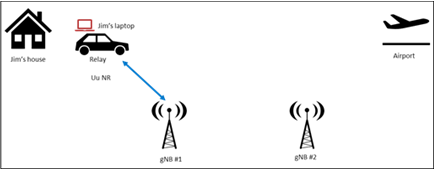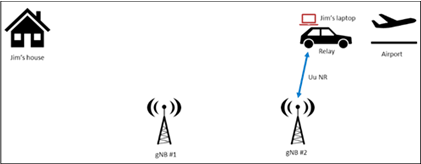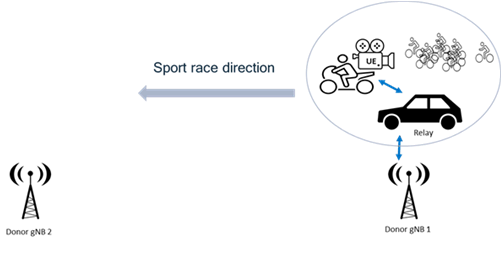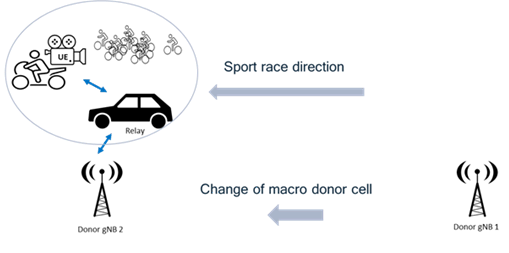Content for TR 22.839 Word version: 18.1.0
5.11.2 Mobility of relay between macro nodes
5.11.2.1 Use case 1: User inside the vehicle
5.11.2.2 Use case 2: User outside the vehicle
...
...
5.11.2 Mobility of relay between macro nodes p. 26
5.11.2.1 Use case 1: User inside the vehicle p. 26
5.11.2.1.1 Description p. 26
While the UE is served by a mobile base station relay, as the vehicle is moving, it is possible for the relay to be handed over to a different macro node. Ensuring that there is no interruption to the ongoing services at the UE will yield an improved user experience.
5.11.2.1.2 Pre-conditions p. 26
Jim is going on a business trip that was scheduled on very short notice. To prepare for the trip, he has set up a conference call with this team that will take place during his commute to the airport using his favorite ride-sharing service, whose vehicles happen to be equipped with mobile station relays.
Jim settles into his ride and opens his laptop which has with a 5G modem. The modem in the laptop registers with the mobile base station relay mounted on the vehicle. Jim starts his conference call and shares the slides he has prepared.

5.11.2.1.3 Service Flows p. 27
- Jim's ride goes onto the highway and heads for the airport. As the vehicle moves away from the city, coverage from the serving macro node to the relay becomes weaker.
- The macro network determines that the relay can be better served by another macro node, and hands over the relay to that macro node. All ongoing services on Jim's laptop, including the conference call with slide sharing, are transferred without service interruption.
- Jim arrives to the airport, thanks his team and ends the conference call.
5.11.2.1.4 Post-conditions p. 27
Jim's conference call and slide sharing were transferred seamlessly during handover of the relay serving Jim's laptop from one macro node to another. Jim is very pleased that he was able to make the most of the ride time and go through the entire slide deck without any interruption in connectivity.

5.11.2.1.5 Existing features partly or fully covering the use case functionality p. 27
Current requirements (e.g. related to wireless self-backhaul, see clause 6.12 of TS 22.261) or existing functionalities (e.g. IAB), cover scenarios of autonomous configuration/adaptation of network topologies, but do not assume or fully address physical relay mobility.
5.11.2.1.6 Potential New Requirements needed to support the use case p. 27
[PR 5.11.2-1]
The 5G system shall be able to support efficient handover of a UE active communication when a mobile base station relay (e.g. serving a UE inside a vehicle) changes between macro network nodes, ensuring end-to-end service continuity during mobility of the relay.
5.11.2.2 Use case 2: User outside the vehicle p. 28
5.11.2.2.1 Description p. 28
In certain scenarios, a mobile base station relay mounted on a vehicle may serve UEs outside, and while the vehicle is moving the relay connection to the macro network can change, i.e. can be handed over to a different macro donor node. In such cases, the system should ensure seamless mobility and service continuity.
The example scenario described here refers to an outdoor sport event (bike or pedestrian race), with motorbikes' camera transmitting real-time video via relays mounted on alongside vehicles, e.g. provided by the event organizer or TV broadcaster. During the race, the vehicle relay changes macro cell coverage, i.e. relay connection is handed over between two macro donor nodes.
5.11.2.2.2 Pre-conditions p. 28
Before the race starts, cameras on motorbikes get configured and connected to a surrounding vehicle relay, providing 5G wireless backhauling connectivity toward a certain PLMN network.
Real-time video transmission starts, and the vehicle relay is connected to macro cell (donor node) #1.

5.11.2.2.3 Service Flows p. 28
(1)
The sport race starts; motorbikes with cameras and cars equipped with relays follow, on the side, the race group/platoon.
(2)
While moving along the race itinerary, the relay coverage and connection quality from macro cell#1 gets weaker, and macro cell#2 becomes a stronger/better cell to connect to.
(3)
Based on NW decision, at a certain point the relay backhaul connection is handed over from cell#1 to cell#2, while UEs (cameras) remain connected to the same relay.
5.11.2.2.4 Post-conditions p. 28
The vehicle relay is connected to macro cell#2, and no service disruption occurred to the ongoing video transmission.

5.11.2.2.5 Existing features partly or fully covering the use case functionality p. 29
Current requirements (e.g. related to wireless self-backhaul, see clause 6.12 of TS 22.261) or existing functionalities (e.g. IAB), cover scenarios of autonomous configuration/adaptation of network topologies, but do not assume or fully address physical relay mobility.
5.11.2.2.6 Potential New Requirements needed to support the use case p. 29
[PR 5.11.2-2]
The 5G system shall be able to support efficient handover of a UE active communication when a mobile base station relay (e.g. serving a UE outside a vehicle) changes between macro network nodes, ensuring end-to-end service continuity during mobility of the relay.